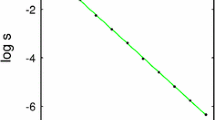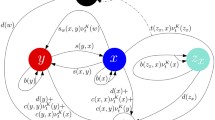Abstract
The probability of tumor extinction due to the action of cytotoxic cell populations is investigated by several one dimensional stochastic models of the population growth and elimination processes of a tumor. The several models are made necessary by the nonlinearity of the processes and the different parameter ranges explored.
The deterministic form of the model is \(\lambda _0 = \gamma _0 - k_6^\prime /K_1 \) where γ0, k′6 and k 1 are positive constants. The parameter of most import is \(Q_\beta \) which determines the stability of the T = 0 equilibrium. With an initial tumor size of one, a (linear) branching process is used to estimate the extinction probability. However, in the case λ = 0 when the linearization of the deterministic model gives no information (T = 0 is actually unstable) the branching model is unsatisfactory. This makes necessary the utilization of a density-dependent branching process to approximate the population. Through scaling a diffusion limit is reached which enables one to again compute the probability of extinction. For populations away from one a sequence of density-dependent jump Markov processes are approximated by a sequence of diffusion processes. In limiting cases, the estimates of extinction correspond to that computed from the original branching process. Table 1 summarizes the results.
Similar content being viewed by others
References
Barbour, A. D.: Density dependent Markov population processes. In: Biological Growth and Spread, Jäger, W., Rost, H., Tautu, P. (eds.), pp. 36–49. Berlin-Heidelberg-New York: Springer 1980
DeLisi, C., Rescigno, A.: Immune surveillance and neoplasia, I. A minimal mathematical model. Bull. Math. Biol. 39, 201–221 (1977)
Dubin, N.: A Stochastic Model for Immunologic Feedback in Carcinogenesis. Berlin-Heidelberg-New York: Springer 1976
Féaux de Lacroix, W., Lennartz, K. J.: Changes in the proliferation characteristics of a solid transplantable tumor of the mouse with time after transplantation. Cell Tissue Kinetics 14, 135–142 (1981)
Garay, R. P., Lefever, R.: A kinetic approach to the immunology of cancer: Stationary states properties of effector target cell reactions. J. Theoret. Biol. 73, 417–438 (1978)
Grossman, Z., Berke, G.: Tumor escape from immune elimination. J. Theoret. Biol. 83, 267–296 (1980)
Jagers, P.: Branching Processes with Biological Applications. London: Wiley, 1973
Karlin, S., Taylor, H. M.: A First Course in Stochastic Processes, 2nd ed. New York: Academic Press 1975
Karlin, S., Taylor, H. M.: A Second Course in Stochastic Processes. New York: Academic Press 1981
Kendall, D. G.: Birth-and-death processes and the theory of Carcinogenesis. Biometrika 47, 13–21 (1960).
Kurtz, T. G.: Approximation of Population Processes, SIAM, 1981
Lefever, R., Garay, R.: A mathematical model of the immune surveillance against cancer. In: Theoretical Immunology, Bell, G. I., Perelson, A. S., Pimbley, G. H. (eds), pp. 481–518. Marcel Dekker, 1978
Lipow, C.: A branching model with population size dependence. Advances in Appl. Probability 7, 495–510 (1975)
Lipow, C.: Limiting diffusions for population-size dependent branching processes J. Appl. Probability 14, 14–24 (1977)
Merrill, S. J.: A model of the role of natural killer cells in immune surveillance—I. J. Math. Biol. 12, 363–373 (1981)
Merrill, S. J.: A model of the role of natural killer cells in immune surveillance—II. J. Math. Biol. 17 153–162 (1983).
Merrill, S. J.: Foundations of the use of an enzyme-kinetic analogy in cell-mediated cytotoxicity. Math. Biosci. 62, 219–235 (1982)
Merrill, S. J.: A stochastic model of sneaking through the immune surveillance mediated by NK cells. Proc. of 1983 Midwest Conf. on Diff. Eqns., Iowa City (To appear)
Rescigno, A., DeLisi, C.: Immune surveillance and neoplasia II. A two-stage mathematical model. Bull. Math. Biol. 39, 487–497 (1977)
Tautu, P.: Biological interpretation of a random configuration model for carcinogenesis. In: Biological Growth and Spread, Jäger, W., Rost, H., Tautu, P. (eds.), pp. 196–220. Berlin-Heidelberg-New York: Springer 1980
Williams, T., Bjerknes, R.: Stochastic madel for abnormal clone spread through epithelial basal layer. Nature 236, 19–21 (1972)
Wofsy, C. (Lipow): Behavior of limiting diffusions for density-dependent branching processes. In: Biological Growth and Spread, Jäger, W., Rost, H., Tautu, P. (eds.), pp. 36–49. Berlin-Heidelberg-New York: Springer 1980
Author information
Authors and Affiliations
Rights and permissions
About this article
Cite this article
Merrill, S.J. Stochastic models of tumor growth and the probability of elimination by cytotoxic cells. J. Math. Biology 20, 305–320 (1984). https://doi.org/10.1007/BF00275990
Received:
Issue Date:
DOI: https://doi.org/10.1007/BF00275990




